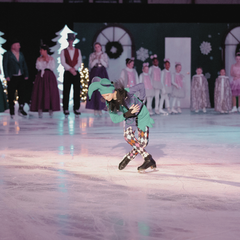 The Jester Doll takes a bow during the Nutcracker on Ice The Jester Doll takes a bow during the Nutcracker on Ice It’s easy to get down on ourselves in this sport because it’s so freaking difficult. There are so many ways a skill can go wrong - spins travel, turns scrape, jumps don’t go up, your feet don’t lean the right way or move quickly enough or move too quickly, the free leg bends, the arms get lost, the head wants to take the lead on takeoff, and your bum can hit the ground at any time. Even if we love the day-to-day grind and working ourselves to the bone–and you have to if you want to make any real progress– there will still be hard moments, weeks, months, and seasons. There will be times when we trip over our toe picks, fall on our kneecaps, can’t remember the steps, kick ourselves in the shin, slip off the heel, split a chin, have an asthma attack, develop tendonitis, collide with another skater, and maybe even break a bone or get a concussion. We get a goal in mind to motivate ourselves, and we know that progress is not a straight line, but when the bummers pile up, and it starts to seem that everyone else is having better days and making more progress than you... how do you keep going? For some adult skaters maybe it’s a little easier than for adolescents–for many adults, skating is their happy place outside of work and family stressors. But for teen and tween skaters who don’t yet have the gift of years to teach them perspective, it’s easy to look at someone else’s journey and feel dejected. Since 2020 one difficult situation after another has come my way. Some have been life-and-death situations, others financial, others mental and emotional, and others have simply been life-changing. And what I’ve come to really see from all of this is that there is a lot of suffering in the world. Everyone on this planet is dealing with something–some way more than others–and none of our blessings are guaranteed. Not a single one. At the time of writing this, I have not been on the ice or able to do a an asana based yoga practice in over 8 weeks due to a hip injury. I will soon have surgery, which will potentially mean another 5 months off. It is well-documented that exercise is a key component of physical and mental health. For many of us, skating is the main form of exercise to help us manage life’s daily stressors and keep our brains happy. For me, yoga is even more important for my mental health than skating. So, when we can’t skate or practice asana (the physical postures), or when we find ourselves feeling down and dejected about skating (or anything), what can we do to help? For me, the answer has been to practice gratitude. That may sound silly, because why be grateful when things have plummeted downhill? I certainly don't mean to deny your feelings in a “good vibes only” sort of way. Recognizing, acknowledging, and releasing emotions is key to our health. However, I also believe we can and should always find something to be grateful for. Since I have not been able to practice asana for what feels like a very long time, and I make efforts not to dwell on the negative, I have made gratitude a key component of my daily routine. (It’s all about where we direct our energy (brahmacharya). So, even though my hip pain is pretty constant, in some ways I feel better than I have in years. With gratitude, optimism is sustainable.
0 Comments
 Young figure skater at peace with the learning process and content with her skating journey Young figure skater at peace with the learning process and content with her skating journey We are figure skaters because we love figure skating, but very often we do things that steal the joy from our experience. We focus on our competitors, badmouth ourselves, beat ourselves up over both big and small mistakes, make excuses for bad habits that we have the power to change, fixate on the things we don’t like about our image (because societal pressure tells us we should look a certain way), spend countless hours scrolling social, and then stay up way too late because we are ruminating over the negative things we’ve experienced throughout the day. It’s not our fault–we are biologically programmed to remember negative information and experiences more easily than positive ones. This is called the negativity bias, and it’s pretty powerful. Just because we have a biological negativity bias doesn’t mean we can’t overcome the negative, though. It’s not easy–some studies estimate that we need at least 5-7 times the positive input for each negative one. The more ingrained the negative experience, the harder it is to change. We are figure skaters, though… we were born ready to tackle the hard! Thanks to neuroplasticity, we can rewire connections in the brain not just in childhood, but well into adulthood, too. First, we have to become aware of our habits, then practice replacing them with more positive and productive habits, and finally, surround ourselves with tools and like-minded people to help us in the process. Yoga can be a big help in this process for several reasons. First, studies show what yogis already know–a regular practice of yoga that includes asana, meditation, and breathwork protects and strengthens the brain . In other words, yoga and neuroplasticity go hand in hand. Second, as I’ve written about many times, the purpose of yoga is to guide us on a path to a fulfilling, happy life, and the entire framework of the 8 limbs is designed for this purpose. (See image below) The mechanism of yoga teaches us to pause and still the mind, which helps us slow down long enough to recognize and observe our habits. And since the first tenet of the 8-limbed path of yoga is ahimsa-non-harm, it makes sense that we would work to stop the harmful habits, thoughts, and behaviors. Then, being honest with ourselves (satya) enough to avoid the consumption of negative energies and ideas (saucha) and direct our energy toward helpful thoughts and behaviors (brahmacharya) with fervor (tapas), we can change our habits. Let’s start by eliminating these three harmful habits that I often see in skating. Life is full of distractions and new, shiny objects that call for our attention and focus. Especially in our modern society which moves faster and faster every day, our brains are conditioned now to seek new thrills, however fleeting they may be. The latest headline, notification, text, or cute cat on our feed, or the next bite of chocolate or sip of Starbucks… all give us little bitty hits of dopamine. The more we lean into these external stimuli for satisfaction, though, the more we are left craving more and more, and the more unsatisfied we become. This is not to say that Starbucks, Hershey’s, Apple, Samsung, Meta, YouTube, and TikTok are inherently bad and that we should never consume them. However, we need to practice enough moderation and separation from such distractions to offer ourselves space to discover our own intuition. The greatest need of our time is to clean out the enormous mass of 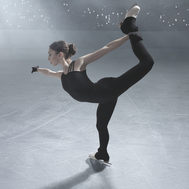 Figure Skater Executing a Spiral Variation Figure Skater Executing a Spiral Variation In last week’s blog I discussed the need for direction in our skating and explained why the common practice of setting SMART goals often doesn’t work for skaters. Without direction, we feel like we are skating in circles, getting nothing accomplished, even while working very hard. It is very frustrating! I’m from Kentucky, so I like to compare it to a thoroughbred–you can be the fastest horse in the world, but if you aren’t trained to run around the track, you can’t run the race. But SMART goals, by far the most common type of goal-setting used, can be harmful for skaters, who are often already highly focused and obsessive, and who thrive on the external validation of achievement. In my experience, the black and white nature of SMART goals creates a lot of anxiety in our already anxious modern beings. If you haven’t read that post, you can find it here. Instead of setting SMART goals, I encourage skaters to set intentions. By definition, an intention is a plan to think and act in a certain way, preferably in alignment with a greater principle or purpose. It involves staying focused and mindful in the present moment, rather than on the future or the past. Since an intention focuses on the present, it comes from the idea that we are already whole because we are all of a divine nature. The idea is that our intended action or thought is already within us… our purpose is to practice bringing it to light simply by getting to work. As always, the practice IS the path. What is a Good Intention for Skaters?In yoga, an intention is also called a Sankalpa, which can also be translated as a resolve or a vow to be upheld above all others.
This doesn’t mean that we forget all our other obligations and become single-minded to the point of obsessiveness (remember–we are trying to leave behind the obsessiveness of SMART goals). It means that we will be resolved to have one mindset or one purpose for each practice or period of practice–whether that period is a season, a month, a week, a day, or an hour. If you really have one quality you want to cultivate in your life, maybe your intention is one word for a season at a time. An example of this is how I choose a word of the year instead of choosing a list of resolutions–abundance, love, courage, flexibility, etc. Then I try to make sure my thoughts, choices, and actions are in alignment with this word. If you practice for many hours a day, you may have one purpose for each session. It can be a word–maybe you choose one of the yamas–or a positive statement or affirmation, such as “I use my breath to stay calm when I run into traffic during my program,” or “I am aware of my self-talk.” You can even make a positive statement about an element you really want to develop–i.e. I easily execute 9 revolutions on a forward camel spin. On your first session, you can focus on program run-throughs and all that entails, and on the next session, you focus on exercises for the camel spin. 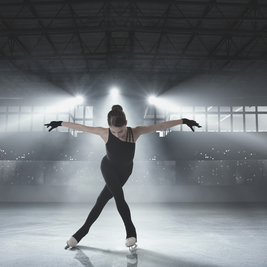 Female Figure Skater in an Opening Pose Female Figure Skater in an Opening Pose For the past several years I have really struggled with focus. I was miserable–my brain darting between tasks, unable to focus on any one thing for more than a few seconds at a time. During the act of teaching things felt fine–it’s naturally faster paced–but sitting to work at a computer for my other job, for writing, or for planning was challenging in a way it never had been. Even though I rarely eat processed foods, aim to get enough sleep, practice meditation, exercise, and drink enough water, I just… couldn’t. be. efficient. I knew something was off, but I still felt like a failure. Then, I read somewhere that “systems will beat hard work and talent every time”. And I realized that I wasn’t failing, but I certainly was spinning my wheels. I think it’s safe to say that, in 2023, the vast majority of humans struggle with focus. It’s impossible to process information as quickly as technology throws it at us. We can’t keep up with our obligations because our brains simply haven’t evolved as quickly as society demands them to. Add in processed foods, lack of sleep, the chaos of the world, and the frenetic pace of achievement we are compelled to follow, and our brains are in crisis. I needed a system and tools to help me dedicate time to do the work that really mattered most – like writing these blogs for the skating world – and to block out distractions. So, I went to work finding tools to help streamline my processes and started practicing their implementation, and I plugged in breaks throughout my day to allow my brain to reset in between tasks. This process has reminded me so much of skating. We’ve all seen skaters spin their wheels on the ice–they get so bogged down with what needs to be done that they move from one thing to the next with no focused effort to make any improvement. Or even worse, they fail to do anything because deciding where to begin is too difficult! In getting to work, it’s all about using your energy in the right way - Brahmacharya. (A few weeks ago I wrote about the yamas - a code of conduct presented to us in the 8 limbs of yoga… Brahmacharya is one of the yamas. You can read more about it here.) Coaches know this, parents know this, and deep down, skaters know it, too. But for it to click and to get a system in place can be very challenging. Enter the SMART goal. 3/18/2023 1 Comment Failing a Figure Skating Test Yogi Tea reminds us to celebrate both our successes and failures Yogi Tea reminds us to celebrate both our successes and failures I wish I had failed more as a skater. Of course, I experienced minor failures every day in practice as I worked to achieve new skills, but not until the end of my career did I fail a test. Most things in skating can only be really learned by doing, and sometimes things don’t really click until you start to learn something even harder. Take jumping, for example. At some point, in order to begin learning a double jump, you have to say that the single is good enough. You continue to work on the single, but you can move on. However, I used to get so angry at myself for making mistakes in practice and needed my skills to be so perfect, that I wouldn’t allow myself to move on to learn new things. I was so terrified of making mistakes, that I stunted my progress and robbed myself of the joy of achievement. Instead, I turned achievement into obligation and a requirement for proving my worth as a human. We can go more in-depth about the pitfalls of perfectionism in a later post, but I will say that the best skaters are the ones who take risks and don’t let failure stop them from trying. They are the ones that can hustle and skate with abandon and really push their limits. So why, then, as a society, do we only celebrate our successes? 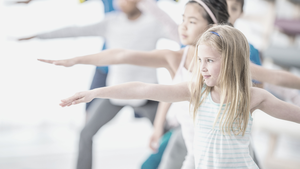 Young skaters practicing yoga Young skaters practicing yoga Whether you are focused on athletic achievement or life lessons, creating a safe space is crucial for the well-being of everyone involved. As a skater, I trained in environments that, from the outside, appeared healthy and safe. There was no physical or sexual abuse that I am aware of, and there was none of the heinous screaming and name-calling that still exists in many rinks. However, when I was younger, my coaches behaved like mean girls in club politics and created ugly rivalries where there should have been collegiality and friendship. Later, at a different facility, my peers had weekly weigh-ins, and I was applauded and revered for drastic weight loss that led me down a decades-long path of eating disorders. In yet another facility, I was made to feel like an imposter–just a “tester” among those actively competing. As a coach, I have always tried very hard not to repeat the mistakes of my teachers. Most of them were good-hearted with good intentions, even if they were often blinded by their own competitive nature and their own past wounds and teachings. So, without a good model in my background, I repeated some of the same mistakes. Pushed kids when they didn’t need to be pushed, compared skaters to one another when I shouldn’t have, offered dietary advice without being a licensed dietitian and tried to convince a skater to stay in the sport when what she really, really wanted was to be done. For many years I coached in an environment that closely followed Safesport guidelines. Yet, it didn’t feel healthy and was arguably quite harmful to me and many others. Playing favorites, forming cliques, ignoring skaters who need extra emotional support, and politicking amongst coaches are surefire ways to ruin a healthy, collegial environment. While Safesport and SkateSafe attempt to prevent and prosecute the most egregious acts of abuse in our sport, they fall short in many ways, especially in instances of emotional abuse. Their shortcomings are beyond the scope of the post, so I will simply say that I believe we need good models of conduct and spirit that go deeper than US Figure Skating’s Code of Conduct and the PSA’s professional standards.  A space for practicing yoga at home A space for practicing yoga at home As a figure skater, beginning a yoga practice–or starting to “do yoga” –can be overwhelming. There is so much information online it’s hard to know who to trust and where to look. Besides, society presents this image of yoga as bubbly young athletes sweating in Lululemon doing crazy poses. The franchise yoga business in many cities has perpetuated this myth. Sure, some yogis are very flexible, even hypermobile, but most of us aren’t. The reality is that all figure skaters already have some experience with the foundations of yoga, whether they know it or not. Spirals, catch spirals, lunges, Biellmanns, split jumps, layback spins, etc. Many of the movements and movement patterns we use in skating are very similar to those of yoga, as is the overall focus on balance, strength, and flexibility. In fact, I was drawn to yoga because when I practiced, it was the first time I felt like my body could move in a somewhat similar, yet more gentle, way than skating, and the first time ever I felt like I could synchronize my breath with my movement. And that was the most powerful tool I had ever experienced. The additional reality is that yoga has something to offer every single skater. In a post a few weeks ago I even talked about how the foundations of yoga - Patanjali’s 8 limbs - relate to the skating journey. In short, I broke down the foundational journey of yoga to show how it parallels some aspects of the figure skating journey:
So back to the original question… where does a skater go to begin “doing yoga”? 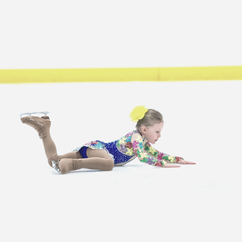 Young Figure Skater Falls During Performance Young Figure Skater Falls During Performance We have all faced nerves and felt anxious before a skating test or competition, right? Sweaty palms, racing heart, nausea, jittery legs, shaking from the cold yet dripping sweat, forgetting your steps, feeling like your head is floating above your body, maybe your coach even sounds like Charlie Brown’s teacher—wah wah wah. When I was a young competitor, I would yawn excessively and tell myself, “I’m not nervous! Look how relaxed I am.” 😅 I didn’t know that I was experiencing performance anxiety, and my coaches didn’t have any words of advice for me. In fact, I was too embarrassed even to admit that I was nervous. In the 80’s and 90’s, performance anxiety was considered a sign of weakness. Either you could handle the stress, or you couldn’t. If you could, you won. If you couldn’t, you “bombed”. And "Sports Psychology" was only for the elite of the elite. So, instead of recognizing my nerves, I internalized the bad skates and told myself, “I’m just not as good as the other skaters.” As a result, I tried to work harder by beating myself up more in practice. Sound familiar? The Role of the Cognitive Triangle in Figure Skating Self-Talk Solo dancer performing a twizzle Solo dancer performing a twizzle The Cognitive Triangle is the foundation of Cognitive Behavioral Therapy (CBT) and is used to treat many mental health issues. It is well-researched and documented and very widely applied to performance related therapies, and as such, is particularly relevant in sports psychology and figure skating performance. Basically, the cognitive triangle diagrams the relationship between our thoughts, feelings, and actions. We have a thought or a belief, which produces a feeling, which leads to anaction or a habit. Then that action or habit produces additional feelings and thoughts, thus continuing the cognitive cycle. In my last blog post I discussed how the Cognitive Triangle is key to our ability to control our actions, our reactions to our environment, and ultimately to our happiness. I am not a therapist or licensed social worker, even though I sometimes wish I were. When I was a young coach, I felt completely unprepared to guide my skaters through the negative thought cycles that often sabotaged their goals and happiness. All I had to advise them with was my sincere emotional investment in their well-being coupled with my own ADHD and anxiety fueled overdrive. Later, after many years of personal therapy and study, I became aware of what I called the Positive Thought Cycle and began applying it to my own life. It didn’t take long for me to appreciate the ability we have as humans to intervene in our own thought processes in order to change our behaviors. |
Author // the skating yogiMy name is Sarah Neal. I have been immersed in the world of figure skating for over four decades. I have seen firsthand the abuse that happens at the higher levels of our sport and experienced how that trickles down into unhealthy training practices and habits at the grassroots. I have seen this play out in the operations of the very institutions that control our sport. Whether for a profession or hobby, pursuing skating should be a joyful, rewarding process, an opportunity for athletic and personal growth, and a place to build lasting friendships. Archives
March 2024
CategoriesAll Athlete Well Being Athlete Well-Being Deep Connections Embodied Movement And Meditation Practices Life After Competition Mindful Living |
Search by typing & pressing enter

 RSS Feed
RSS Feed